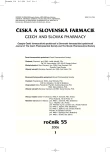Explant Culture of Trifolium pratense L.
Explantátová kultura Trifolium pratense L.
Perspektivním zdrojem flavonoidů a isoflavonoidů s fytoestrogenní aktivitou se jeví jetel luční. Z klíční rostliny čtyř různých odrůd Trifolium pratense L. byla odvozena kalusová a suspenzní kultura. Pro kultivaci je optimální živné médium podle Gamborga s přídavkem 2 mg.l⁻¹ 2,4-dichlorfenoxyoctové kyseliny a 2 mg.l⁻¹ 6-benzylaminopurinu. Na základě růstové a produkční charakteristiky byl stanoven u kalusové kultury subkultivační interval 29 až 43 dní, u suspenzní kultury subkultivační interval 16 až 23 dní. Pomocí TLC a HPLC bylo zjištěno, že explantátová kultura Trifolium pratense L. obsahuje isoflavonoid formononetin.
Klíčová slova:
Trifolium pratense L. – odvození kalusové a suspenzní kultury – růstová a produkční charakteristika – flavonoidy a isoflavonoidy
Authors:
M. Kašparová; T. Siatka; J. Spilková; J. Dušek
Authors‘ workplace:
Farmaceutická fakulta Univerzity Karlovy, Hradec Králové, Katedra farmakognozie
Published in:
Čes. slov. Farm., 2006; 55, 44-47
Category:
Original Articles
Overview
The red cloverl seems to be a prospective source of flavonoids and isoflavonoids with phytoestrogenic activity. Young seedlings of four different varieties of Trifolium pratense L. were employed to derive callus and suspension cultures. The optimal medium for cultivation is Gamborg’s cultivating medium with an addition of 2 mg.l⁻¹ of 2,4-dichlorphenoxyacetic acid and 2 mg.l⁻¹ of 6-benzylaminopurine. On the basis of growth and production characteristics, subcultivating intervals of 29 to 43 days in callus culture and 16 to 23 days in suspension culture were determined. TLC and HPLC revealed that the explant culture of Trifolium pratense L. contains the isoflavonoid formononetin.
Key words:
Trifolium pratense L. – derivation of callus and suspension cultures – growth and production characteristics – flavonoids and isoflavonoids
Labels
Pharmacy Clinical pharmacologyArticle was published in
Czech and Slovak Pharmacy

2006 Issue 1
Most read in this issue
- Natural Polymers in the Formulation of Hydrophilic Matrix Tablets
- Stabilization of Colouring of Castellani’s Solution without Fuchsin Ph.B. MMII and Control of Its Efficacy
- Prescription of Health Requisites to Patients
- Separation of Dimetinden Enantiomers in Drugs by Means of Capillary Isotachophoresis
